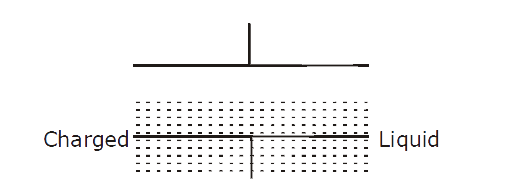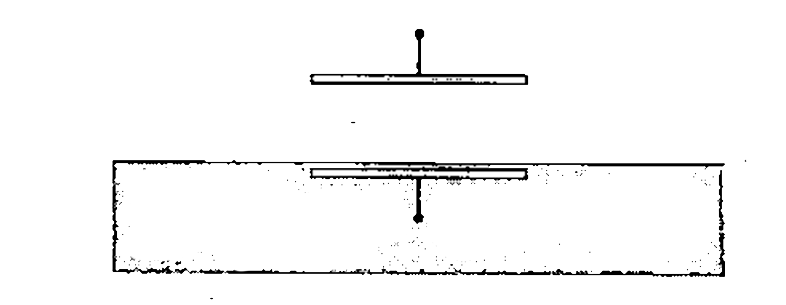A parallel plate capacitor is located horizontally such that one of the plates is submerged in liquid while the other is above the liquid surface. When plates are charged, the level of liquid.

rises
falls
remains unchanged
may rise of fall depending on the amount of a charge
The correct Answer is:A
When plates of the capacitor are charged, then opposite charges are induced on water (dielectric), so due to attractive force, level of liquid rises.
Topper's Solved these Questions
- ELECTROSTATICSBOOK - MHTCET PREVIOUS YEAR PAPERS AND PRACTICE PAPERSCHAPTER - ELECTROSTATICSEXERCISE - MHT CET Corner
29 Videos
- ELECTROSTATICSBOOK - MHTCET PREVIOUS YEAR PAPERS AND PRACTICE PAPERSCHAPTER - ELECTROSTATICSEXERCISE - PRACTICE EXERCISE (Exercise 1 (TOPICAL PROBLEMS))
87 Videos
- ELECTRONS AND PROTONSBOOK - MHTCET PREVIOUS YEAR PAPERS AND PRACTICE PAPERSCHAPTER - ELECTRONS AND PROTONSEXERCISE - MHT CET CORNER
19 Videos
- FORCEBOOK - MHTCET PREVIOUS YEAR PAPERS AND PRACTICE PAPERSCHAPTER - FORCEEXERCISE - Exercise 2 (Miscellaneous Problems)
19 Videos
Similar Questions
Knowledge Check
A parallel plate capacitor is located horizontally such that one of the plates is submerged in a liquid while the other is above the liquid surface. When plates are charged, the level of liquid.
 ArisesBfallsCremains unchangedDmay rise of fail depending on the amount of charge
ArisesBfallsCremains unchangedDmay rise of fail depending on the amount of chargeA parallel plate capacitor is located horizontally, so that one of its plates is submerged into liquid while the other is over the surface. The dielectric constant of the liquid is equal to k. Its density is equal to ρ. To what height will the level of the liquid in the capacitor rise after its plates gets a charge of surface density σ ?
 .Ah=(k2−1)σ22ε0k2ρgBh=(k−1)σ2ε0kρgCh=2(k−1)σ2ε0kρgDh=0
.Ah=(k2−1)σ22ε0k2ρgBh=(k−1)σ2ε0kρgCh=2(k−1)σ2ε0kρgDh=0A parallel plate capacitor is charged. If the plates are pulled apart
Athe potential difference increasesBthe capacitance increasesCthe total charge increasesDthe charge and the potential difference remain the same
A parallel plate capacitor is charged and then isolated. On increasing the plate separation
View SolutionIn a parallel plate capacitor with plate area A and charge Q, the force on one plate because of the charge on the other is equal to
View SolutionFigure shows a horizontal parallel plate capacitor is lowered on a liquid surface in such a way that its lower plate is just submerged in the liquid of dielectric constant k. Find the height to which the liquid level will be raised between the plates if the capacitor plates are given a surface charge density +σ and−σ on its plates.

View SolutionA parallel plate capacitor is charged and then isolated. On increasing the plate separation
View SolutionIn a parallel plate capacitor with plate area A and charge Q, the force on one plate because of the charge on the other is equal to
View Solution
